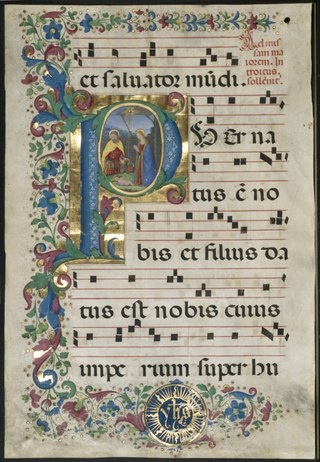
Medina, officially Al Madinah Al Munawwarah (Arabic: المدينة المنورة, romanized: al-Madīnah al-Munawwarah, lit. 'The Enlightened City', Hejazi pronunciation: [almadiːna almʊnawːara], and also commonly simplified as Madīnah or Madinah, is the second-holiest city in Islam and the capital of Medina Province in the Hejaz region of western Saudi Arabia. As of 2020, the estimated population of the city is 1,488,782, making it the fourth-most populous city in the country. Located at the core of the Medina Province in the western reaches of the country, the city is distributed over 589 km2, of which 293 km2 constitutes the city's urban area, while the rest is occupied by the Hejaz Mountains, empty valleys, agricultural spaces and older dormant volcanoes.

Calligraphy is a visual art related to writing and is the design and execution of lettering with a pen, ink brush, or other writing instrument. Contemporary calligraphic practice can be defined as "the art of giving form to signs in an expressive, harmonious, and skillful manner".

The terms Muslim world and Islamic world commonly refer to the Islamic community, which is also known as the Ummah. This consists of all those who adhere to the religious beliefs and laws of Islam or to societies in which Islam is practiced. In a modern geopolitical sense, these terms refer to countries in which Islam is widespread, although there are no agreed criteria for inclusion. The term Muslim-majority countries is an alternative often used for the latter sense.
Nur al-Din is a male Arabic given name, translating to "light of Faith", nūr meaning "light" and dīn meaning "religion". More recently, the name has also been used as a surname.

Annemarie Schimmel was an influential German Orientalist and scholar who wrote extensively on Islam, especially Sufism. She was a professor at Harvard University from 1967 to 1992.

Islam has been practiced in China since the 7th century CE. Muslims are a minority group in China, representing 1.6 to 2 percent of the total population (21,667,000-28,210,795) according to various estimates. Though Hui Muslims are the most numerous group, the greatest concentration of Muslims are in Xinjiang, which contains a significant Uyghur population. Lesser yet significant populations reside in the regions of Ningxia, Gansu and Qinghai. Of China's 55 officially recognized minority peoples, ten of these groups are predominantly Sunni Muslim.

Islamic calligraphy is the artistic practice of handwriting and calligraphy, in the languages which use Arabic alphabet or the alphabets derived from it. It includes Arabic, Persian, Ottoman, and Urdu calligraphy. It is known in Arabic as khatt Arabi, which translates into Arabic line, design, or construction.

The Great Mosque of Xi'an is one of the largest premodern mosques in China. Although the mosque was first built in the year 742 AD during the Tang dynasty, its current form was largely constructed in 1384 AD during Emperor Hongwu's reign of the Ming dynasty, as recorded by the Records of Xi'an Municipality (西安府志).

The Niujie Mosque is the oldest mosque in Beijing, China. It was first built in 996 during the Liao dynasty and was reconstructed as well as enlarged under the Kangxi Emperor of the Qing dynasty.
Islamic culture and Muslim culture refer to cultural practices which are common to historically Islamic people. The early forms of Muslim culture, from the Rashidun Caliphate to the early Umayyad period and the early Abbasid period, were predominantly Arab, Byzantine, Persian and Levantine. With the rapid expansion of the Islamic empires, Muslim culture has influenced and assimilated much from the Persian, Egyptian, North Caucasian, Turkic, Mongol, Indian, Bangladeshi, Pakistani, Malay, Somali, Berber, Indonesian, and Moro cultures.

Mashq is one of the oldest calligraphic forms of the Arabic script. At the time of the emergence of Islam, this type of writing was likely already in use in various parts of the Arabian Peninsula. It is first attested during the reign of caliph Umar, making it one of the earliest forms of Arabic script, along with Hijazi and Kufic. It was used in most texts produced during the first and second centuries after the Hijra.

Sini is a calligraphic style used in China for the Arabic script. It can refer to any type of Chinese Arabic calligraphy, but is commonly used to refer to one with thick and tapered effects such as seen in Chinese calligraphy. It is used extensively in mosques in Eastern China and to a lesser extent in Gansu, Ningxia and Shaanxi.

Hakeem Noor-ud-Din was a close companion of Mirza Ghulam Ahmad, the founder of the Ahmadiyya Movement, and was chosen as his first successor on 27 May 1908, a day after his death, becoming the first caliph and leader of the worldwide Ahmadiyya Muslim Community.

Tan Sri Dato' Seri Tuan Guru Haji Abdul Hadi bin Awang is a Malaysian politician and religious teacher who has served as Member of Parliament (MP) for Marang since October 1990, 7th President of the Malaysian Islamic Party (PAS), an Islamist political party and a component party of Perikatan Nasional (PN) coalition, since July 2002. He served as Leader of the Opposition from July 2002 to March 2004, Menteri Besar of Terengganu from December 1999 to March 2004 and Member of the Terengganu State Legislative Assembly (MLA) for Ru Rendang from 1986 until 2018. At the international level, he also serves as vice-president of the International Union of Muslim Scholars.

Nur is a common Arabic unisex name meaning "light", "The Divine Light". An-Nur, meaning "the light" in Arabic. It can also be feminized as Nura or Noora.

Chinese people in Egypt form one of the smaller groups of overseas Chinese; however, they are a very diverse community with a history reaching back for over a century.

People's Republic of China – Egypt relations were established on May 30, 1956.
Muhammad 'Ilish, more commonly referred to in Muslim works simply as 'Ilish or Sheikh 'Ilish, was a 19th-century CE Egyptian Muslim jurist of Tripolitanian origin. 'Illish was an important late scholar of the Maliki school of Islamic jurisprudence (fiqh). He is perhaps the last of a line of widely read and respected sources of traditional fatwas of the late Maliki school from an Azharite scholar. 'Ilish was an extremely popular teacher at Al-Azhar. His lectures were regularly attended by audiences of over 200 students. In July 1854, 'Ilish was appointed the Maliki Mufti of Al-Azhar. By the time of his death in 1882, 'Ilish was one of the premier leaders of Egyptian scholarly society. His Manh al-Jalil as well as his Fatawa are widely used today among traditional Malikis for fatwa positions of the school.
Soraya Syed Sanders is an English classically trained Islamic calligrapher and artist. She uses classical Arabic calligraphy with new technologies such as holography, placing a traditional art-form into contemporary context.

Calligraffiti is an art form that combines calligraphy, typography, and graffiti. It can be classified as either abstract expressionism or abstract vandalism. It is defined as a visual art that integrates letters into compositions that attempt to communicate a broader message through writing that has been aesthetically altered to move beyond the literal meaning. Simply put, it is the conscious effort of making a word or group of words into a visual composition. As such it is meant to be both an aesthetic experience and provocative art—mixing tradition and precision with modern unbridled self-expression.
















